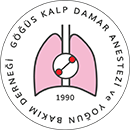

Volume: 28 Issue: 1 - 2022
| 1. | Frontmatters Pages I - X (442 accesses) |
| RESEARCH ARTICLE | |
| 2. | The Relationship of Post-Operative FIB-4 Index Value with Morbidity and Early Mortality in Cardiac Surgery: A Retrospective Study Hülya Yılmaz Ak, Yasemin Özşahin, Mehmet Ali Yeşiltaş, Kerem Erkalp, Ziya Salihoğlu, Barış Sandal doi: 10.14744/GKDAD.2022.34735 Pages 1 - 6 (693 accesses) Objectives: Hepatic injury is seen in 10% of patients who underwent cardiopulmonary bypass (CPB). The fibrosis-4 (FIB-4) index is a non-in-vasive scoring method for detecting liver failure and liver fibrosis. We aimed to examine the effect of FIB-4 index value changes, which is mea-sured in the early post-operative period, on morbidity and early mortal-ity in cardiac surgery patients. Methods: All patients had undergone elective coronary artery bypass graft surgery with standard sternotomy in the 2 years and were included in the study. In our study, the change in the pre- and post-operative period of the FIB-4 index, which was calculated in the pre-operative and post-op-erative period, was examined. Patients demographic values, perioperative complications, amount of bleeding, total amount of fluid administered, and blood gas during cardiovascular bypass values were recorded. Results: Patients were divided into two groups as those with FIB-4 index below 3.25 (Group 1) and above (Group 2). Group 1 consisted of 41 (27.2%) patients and Group 2 consisted of 110 (72.8%) patients. Although the mean time to intubate was higher in Group 2, no significant difference was found between the groups. The length of stay in the intensive care unit was significantly higher in Group 2 (p=0.033). When the 30-day mortality was compared, no difference was found between the groups (p=0.684). Conclusion: It was observed that patients with high FIB-4 index have longer intensive care unit stay, which is an important morbidity criterion for cardiac surgery. We think that the post-operative period FIB-4 index may be effective in estimating morbidity in cardiac surgery patients. |
| 3. | The Effect of One-Lung Ventilation on Cerebral Oxygenation and Neurocognitive Functions Kübra Taşkın, Gülten Arslan, Fatih Doğu Geyik, Cansu Akın, Recep Demirhan, Banu Çevik doi: 10.14744/GKDAD.2022.32656 Pages 7 - 14 (742 accesses) Objectives: It is aimed to show the effect of one-lung ventilation (OLV) on cerebral oxygenation and neurocognitive functions. Methods: Fifty ASA I-III patients who will undergo thoracic surgery and OLV for more than 1 h were included in the prospective study. Standard-ized Mini-Mental State Examination (SMMSE) was applied to evaluate the pre-operative neurocognitive functions. The patients were divided into two groups as non-desaturation (n=32) and desaturation (n=18). The same test was repeated on the 3rd and 7th post-operative days. Results: Considering the mean age, ASA score, and duration of surgery and OLV of the desaturation group, it was found that the basal rSO2 val-ues were significantly higher than the non-desaturation group. In both groups, a decrease was observed in the SMMSE values on the post-opera-tive 3rd day, but the decreases were found to be significant on the 3rd and 7th days in the desaturation group. In the desaturation group, a statistically significant correlation was found between the percentage changes in the post-operative 3rd and 7th days according to the pre-operative SMMSE val-ues and the percentage changes in rSO2 compared to the baseline. There was a significant positive correlation between mean arterial pressure and rSO2 in the lateral decubitus position in both groups. Conclusion: As a result, many conditions may cause cerebral desatu-ration in OLV; it is thought that this should be followed up closely by cerebral oximetry and thus post-operative neurocognitive dysfunction and other complications can be prevented. |
| 4. | Evaluation of Risk Factors for Respiratory Complications After Lung Resection Yücel Özgür, Ayşe Ulukol doi: 10.14744/GKDAD.2022.21704 Pages 15 - 23 (565 accesses) Objectives: Respiratory complications are an important contributor to morbidity and mortality following lung resection. The surgical tech-niques used and the patients pre-operative medical condition deter-mine the severity of complications. The aim of this study is to evaluate the relationship between the perioperative characteristics of patients undergoing lung resection and the development of pulmonary com-plications (PC). Methods: We retrospectively reviewed the records of 1186 patients who underwent lung resections between 2017 and 2020 and identified 124 patients who developed PC. A group of 215 consecutive patients who underwent surgery during the same period and did not develop complications were included as the control group. The groups were compared to evaluate risk factors for PC. Results: The patients had a mean age of 58.9±12.1 (range, 18-83) years and 82% were men (n=278). Factors significantly associated with PC were age over 65 years, male sex, presence of chronic heart failure, coronary artery disease, and chronic obstructive pulmonary disease, undergoing pneumonectomy, intraoperative use of blood products, reoperation due to bleeding, operative time longer than 4 h, and intraoperative inotrope use. Independent variables for PC were intraoperative inotrope use, pre-operative anticoagulant use, revision due to hemorrhage, high Sequential Organ Failure Assessment (SOFA) score, low Forced Expiratory Volume in the 1st s (FEV1), and low preoperative hemoglobin values. Conclusion: This study demonstrated the presence of many risk factors for PC after lung resection. In our study, independent risk factors for PC; intraoperative inotropic use, preoperative anticoagulant use, revision due to bleeding, high SOFA score, low FEV1, and low preoperative he-moglobin values were observed. |
| 5. | Management of Patients with Flail Chest Diagnose in the Intensive Care Unit Mehmet Duran, Ömer Cenap Gülyüz, Nurgül Çetgen, Mehmet Şirin Mağaç doi: 10.14744/GKDAD.2022.55376 Pages 24 - 28 (921 accesses) Objectives: Flail chest due to thoracic trauma causes serious morbidity and mortality. We aimed to investigate the factors affecting the length of stay in the intensive care unit and hospital and the time spent on mechanical ventilation in patients who were followed up and treated with the diagnosis of flail chest. Methods: Our study was designed retrospectively. The effects of the treatment method (medical/surgical), demographic data, development of hemothorax and pneumothorax, time spent on mechanical ventila-tor, and duration of stay in the intensive care unit on the duration of discharge were examined. Results: A total of 30 patients were included in the study. The mean age was 50.1±20.6 (5 females-25 males). The number of those who received medical treatment was 18 (60%), and surgical treatment was 12 (40%). Although the rate of being connected to a mechanical ventilator was higher in those who received surgical treatment, the duration of stay on the mechanical ventilator was found to be shorter. Longer hospital stay was found in male patients and patients who developed hemothorax. Conclusion: When the factors affecting the length of stay in the inten-sive care unit, hospital and mechanical ventilator in patients followed up with the diagnosis of flail chest are examined; It was observed that the duration of mechanical ventilation was shortened in patients who underwent surgical rib fixation and the duration of hospitalization was prolonged in patients with hemothorax and in male patients. |
| 6. | Retrospective Evaluation of Central Venous Catheter Malpositions in Thoracic Surgery Patients Umut Kara, Mehmet Emin İnce, Merve Şengül İnan, Fatih Şimşek, Gökhan Özkan, Serkan Şenkal, Ahmet Coşar doi: 10.14744/GKDAD.2022.22043 Pages 29 - 35 (725 accesses) Objectives: Central venous catheter (CVC) placement is a common procedure performed in thoracic surgery practice and in the early post-operative period, a chest X-ray is a routine procedure. The aim of this study was to investigate the prevalence of CVC tip malpositions in tho-racic surgery patients. Methods: Chest radiographs of patients who were operated on by tho-racic surgeons for 5 years were examined. The region between the lower superior vena cava and the atriocaval junction was assigned as Position 1, the middle-upper superior vena cava region was assigned as Position 2, the right atrium was assigned as Position 3, and the regions outside of these were assigned as Position 4. Position 1 was evaluated as no malpo-sition. Positions 2, 3, and 4 were evaluated as there is malposition. Results: The data of 392 patients were evaluated. Catheters inserted in the left internal jugular vein had the most malposition (73.9%), followed by the catheters inserted in the left subclavian vein (62.2%). A number of 50.2% of catheters were evaluated to be in the right positions. Accord-ing to the CVC tip positions, there was a statistically significant difference between CVC insertion sites (p<0.001). Malpositions of catheters placed from the left were found to be in Position 2, whereas malpositions of cath-eters placed from the right were found to be in Position 3. Conclusion: The prevalence of CVC tips outside of the recommended location is a common that is often overlooked. Understanding the fac-tors that may lead to malposition and implementing appropriate mea-sures, we believe and will lessen the risk of malposition. |
| 7. | COVID-19 Could Be More Severe and Fatal in the Octogenarian and Nonagenarian Population in Intensive Care Unit Behiye Deniz Kosovali, Büşra Tezcan, Nevzat Mehmet Mutlu, Seval İzdeş doi: 10.14744/GKDAD.2022.39259 Pages 36 - 41 (597 accesses) Objectives: In this study, it was aimed to determine demographic and clinical characteristics, supportive treatments in intensive care unit (ICU), mortality rates and factors affecting mortality by grouping COVID-19 in-tensive care patients as octogenarian and nonagenarian groups, and patients younger than 80-years-old. Methods: The patients aged ≥18 years diagnosed with COVID-19 with PCR positivity in ICUs between March 19, 2020 and March 31, 2021 were included in this retrospective observational study. Results: Of the 1004 PCR positive patients, 58.7% were male. The youngest patient was 20, the oldest patient was 100-years-old. There were 738 patients in Group 1 (20-79 years) and 266 patients in Group 2 (≥80 years). Between the two groups, gender, APACHE II score, need for intubation, need for vasopressor/inotrope, and patients in need of care were higher in Group 2 (p<0.001 for all). Only the patients in Group 1 were established ECMO. Hypertension (HT), cardiovascular, respira-tory and neurological diseases, number of comorbidity, and mortality rate were higher significantly in Group 2 (p<0.001, p=0.001, p=0.006, p<0.001, p<0.001, and p<0.001; respectively). Age, male gender, HT, in-tubation, and vasopressor/inotrope requirement were found to be pre-dictors of mortality. Conclusion: COVID-19 may have a more severe and fatal course in the octogenerian and nonagenerian age group with high comorbidity in the ICU. |
| 8. | Awareness of Anesthesiology Practices in the Coronavirus Disease 2019 Pandemic and Coronavirus Disease 2019 Normalization Period Yasir İlyas, Ali Akdoğan, Ahmet Can Şenel doi: 10.14744/GKDAD.2021.27676 Pages 42 - 49 (440 accesses) Objectives: On March 11, 2020, the World Health Organization declared the new coronavirus disease 2019 (COVID-19) as a global epidemic. This study aims to assess anesthesiology and reanimation physicians knowl-edge of the anesthesiology practices published by the Turkish Republic Ministry of Health during pandemic period, their awareness in Turkey. Methods: This descriptive cross-sectional study included 2834 anes-thesiologist physicians who are members of Turkish Society of Anesthe-siology and Reanimation. Data were collected online over 8 weeks using a questionnaire form by SurveyMonkey (San Mateo, CA) website after national and local ethics committee approval. Results: The study included 332 physicians (research associates and spe-cialist physicians). Eighteen participants were excluded from the study since they merely gave their consent and did not respond to the questions. It was determined that participants level of awareness about the possi-bilities of protection during the pandemic period was high, a low level of awareness about preparation for the operating room and case manage-ment, and a high level of understanding about the normalization period. Conclusion: Anesthesiology and reanimation physicians had a mod-erate understanding and awareness of COVID-19 perioperative man-agement. Physicians were observed to have inadequate knowledge of algorithms for personal protective equipment, equipment disinfection protocol, and general anesthesia. In this era of easier access to the cur-rent information, it is critical to maintaining the highest level of knowl-edge and awareness among anesthesiology and reanimation physi-cians who manage the COVID-19 pandemic, to ensure the continuity of training to transfer them to team members, and to carry out procedures following the recommendations. |
| 9. | Causes of COVID-19s Mortality and Prognostic Effect of Neutrophile-Lymphocyte Ratio Mesut Öterkuş, Leman Acun Delen doi: 10.14744/GKDAD.2021.94834 Pages 50 - 55 (469 accesses) Objectives: In this study, we aimed to investigate the prognostic value of the neutrophile-lymphocyte ratio and the effects of age, gender, and comorbidities on mortality. Methods: In our study, 100 patients who had a ground-glass opacifica-tion on computed thorax tomography and who had a positive poly-merase chain reaction test were included in our study. Demographic data, laboratory data and comorbidities of the patients were recorded. Results: Sixty-five (65%) of the patients participating in the study were male. The mean age of the patients was 66 (21.5). The mortality rate was found to be 27% (n=27) High neutrophile-lymphocyte ratio, low lympho-cyte count, high urea, and creatin levels were significant in terms of mor-tality. In addition, advanced age, diabetes mellitus, and hypertension are other factors that have an impact on mortality. Conclusion: The neutrophile-lymphocyte ratio can solely be used as a prognostic marker because it is simple and economical. |
| 10. | Comparison of High-Risk Pulmonary Embolism Patients with and without COVID-19 Bengü Şaylan, İsmail Selçuk, Bülent Barış Güven, Tayfun Çalışkan, Nehir Selçuk, İnsa Gül Ekiz İşcanlı doi: 10.14744/GKDAD.2022.32848 Pages 56 - 63 (591 accesses) Objectives: There has been a significant increase in pulmonary embolism (PE) cases during the coronavirus disease of 2019 (COVID-19) pandemic. In this study, we aimed to compare the effects of COVID-19 positivity on morbidity and mortality in patients treated with a diagnosis of high-risk PE. Methods: In this single-center and observational study, patients who were referred to our center with the diagnosis of PE between January 1, 2019 and 2021 were retrospectively evaluated. Patients with moder-ate- and low-risk PE according to the European Society of Cardiology PE guidelines, those who did not undergo computed tomography pul-monary angiography (CTPA) or the ones who did not accept treatment were excluded from the study. The patients included in the study were divided into two groups, as those with and without COVID-19, and com-pared in terms of demographic data, comorbidities, symptoms, throm-boembolism in vessels other than the pulmonary artery, laboratory pa-rameters, treatments, and prognosis. Results: A total of 384 PE cases were identified during the study pe-riod. Among them, 322 cases that were in the intermediate or low-risk category, 21 cases who did not undergo CTPA, and one case who did not accept thrombolytic therapy were excluded from the study. A total of 40 cases were included in the study. The groups with and without COVID-19 consisted of 23 and 17 patients, respectively. In the group of patients with COVID-19, inflammatory markers were higher, Wells score was lower, and thromboembolism was seen in vessels other than the pulmonary artery. The two groups were similar in terms of other labo-ratory parameters, demographic data, comorbidities, symptoms, treat-ment, and prognosis. Conclusion: While the involvement of COVID-19 in PE etiology does not change mortality, it may cause more thrombosis development in both venous and arterial systems outside the pulmonary area by sig-nificantly increasing inflammation. However, the lower Wells scores in COVID-19 PE cases in our study indicate that new clinical assessment tools are needed to detect PE risk in COVID-19 patients. |
| 11. | Evaluation of Chest Pain and Dyspnea Symptoms Using Speckle-Tracking Echocardiography in Patients Recovering from COVID-19 Timor Omar, Doğan İliş, Yusuf Oflu, Muammer Karakayalı, Halil Murat Bucak, İnanç Artaç doi: 10.14744/GKDAD.2022.24654 Pages 64 - 69 (527 accesses) Objectives: At present, clinicians face plenty of patients complaining of post-COVID-19 chest pain and dyspnea. However, it remains to be seen if these symptoms indicate pathology of the cardiovascular system. We aimed to evaluate heart functions in outpatients with post-COVID-19 chest pain and dyspnea, using 2D speckle-tracking echocardiography (2D-STE). Methods: This cross-sectional study recruited consecutive patients who presented to cardiology outpatient clinics between June 15, 2021, and July 15, 2021. A total of 78 patients had recovered from COVID-19 1-2 months before admission were included in the study. ECG and echo-cardiography, including 2D-STE images, were obtained for all patients. Findings were compared with sex- and an age-matched control group of 67 healthy adults. Results: The median age was 38 (IQR, 34-45) years, and 64.1% were fe-male. There were no significant differences between the patients and control group regarding laboratory, ECG, and echocardiography findings. Moreover, the left ventricle global longitudinal strain measurements in both the patient and control groups were within the normal ranges and did not show a significant difference (-20.5 [-21.8- -17.9] vs. -19.8 [-21.4--18.9], p=0.894). Conclusion: Post-COVID-19 chest pain and dyspnea are unlikely signs of cardiovascular involvement in outpatient young adults who have not been hospitalized with COVID-19. |
| 12. | Evaluation of the Frequency of Atelectasis by Transthoracic Lung Ultrasound in Patients Undergoing Laparoscopic Bariatric Surgery Under General Anesthesia Derya Erol, Mustafa Kemal Arslantaş, Gülbin Töre Altun, Pelin Çorman Dinçer, Elif Aslı Karadeniz, Hilmi Ömer Ayanoğlu doi: 10.14744/GKDAD.2022.74317 Pages 70 - 80 (782 accesses) Objectives: Both obesity and laparoscopic surgical methods are pre-disposing factors for atelectasis. We aimed to evaluate with lung ultra-sound (US), the incidence and location of atelectasis in patients under-going laparoscopic bariatric surgery. Methods: Patients (n=143) between the ages of 18 and 65, BMI ≥30, and ASA 2-3 who underwent laparoscopic bariatric surgery were in-cluded in our prospective observational study. According to the lung US protocol, a total of 12 areas (anterior, lateral, and posterior areas divided into upper and lower regions) were scanned in both hemithorax preop-eratively and in the 1st h after surgery. In the perioperative period, vital parameters and mechanical ventilation parameters were recorded. The images were evaluated blindly by two anesthesiologists experienced in lung US according to the modified lung US scoring system (LUS). Results: When the pre-operative and post-operative LUS scores were compared, we observed an increase in the LUS score in all areas except for both anterior upper areas (p<0.001). This increase was more pro-nounced, especially in the posterior and inferior parts of the lungs. We found the frequency of atelectasis to be 81.1%. The pCO2 values were increased (p<0.001) while the pO2 values were decreased (p<0.001) dur-ing the pneumoperitoneum and post-operative period as compared to the post-intubation period. During pneumoperitoneum, Ppeak values were increased while compliance values were decreased. Conclusion: Lung US can be used in the diagnosis of atelectasis in obese patients. Atelectasis is seen at a high rate in patients undergoing laparoscopic bariatric surgery. |
| 13. | The Incidence and Etiology of Artifacts in Transesophageal Echocardiography Gülbin Töre Altun, Alper Kararmaz, Zuhal Aykaç doi: 10.14744/GKDAD.2022.84834 Pages 81 - 88 (961 accesses) Objectives: Artifacts encountered during perioperative TEE may lead to misdiagnosis or underdiagnosis, which may ultimately result in wrong treatment and surgical referral. In our study, we aimed to inves-tigate the incidence, type, and etiology of artifacts encountered during perioperative TEE imaging. Methods: TEE images that were acquired during cardiovascular sur-geries are retrieved from the echocardiography machine archives and evaluated. The type and factors leading to artifacts in the images are recorded. Results: The images of 86 patients (male n: 50 and female n: 36) were evaluated. A total of 858 windows, of which 94 were stable and 764 were immobile, were evaluated. The artifacts were present in 159 (19%) of the images. The most prominent artifact was acoustic shadowing (p<0.05). The incidence of linear artifact and comet-tail artifact was sta-tistically significantly high as compared to other artifacts. The etiologic factors leading to acoustic shadowing were revealed as annulus and rings in 28 cases (64%), calcifications in 9 cases (20%), and catheters in 7 cases (16%). The incidence of artifacts caused by annulus and rings was statistically significantly high (p<0.05). Comet tail artifact was present in 30 cases (19%) and aortic plaque, air bubbles, and prostatic valves (66%, 17%, and 17%, respectively) were the leading etiologic factors in its formation (p<0.05). Conclusion: Approximately one-fifth of the TEE images that we exam-ined contained artifacts. Acoustic shadowing, linear artifact, and comet tail appearance were the most frequently observed artifacts. Etiological factors were often foreign materials in the heart and calcifications. |
| 14. | PRISM and APACHE II Scoring Systems in Pediatric Cardiac Surgery Intensive Care Unit Serkan Basman, Zeliha Alıcıkuş Tuncel, Gül Çakmak doi: 10.14744/GKDAD.2022.28190 Pages 89 - 96 (1332 accesses) Objectives: This study aims to investigate the reliability and validity of the Pediatric Risk of Mortality (PRISM) score in determining the mortality in patients who have undergone arterial switch in pediatric cardiac sur-gery (PCS) intensive care unit (ICU), to compare these scoring systems with the Acute Physiology and Chronic Health Evaluation (APACHE) II scoring system modified as per the pediatric age group, and to establish the most appropriate scoring system according to the patient charac-teristics and intensive care conditions. Methods: Performed retrospectively in 124 patients within the age range of 0-1 months between January 2005 and August 2011 in the PCS ICU of Dr. Siyami Ersek Thoracic and Cardiovascular Surgery Training and Research Hospital. Results: The correlation analysis performed to establish the relationship between the PRISM score on day 1 and the mechanical ventilation time revealed a positive significant relationship between the scores (r=0.342; p<0.001). Accordingly, as the PRISM score on day 1 increases, the me-chanical ventilation time also increases. The PRISM scores on day 1 and day 3 were found significantly high in exitus patients compared to the survivors (p<0.001 and p=0.049, respectively). The results were evalu-ated at 95% confidence interval. Conclusion: The PRISM score is an important indicator in estimating the mortality in our ICU as in the literature. Further multicenter studies in more patient groups are required to do planning to improve the treatment ser-vices and results in pediatric intensive care unit throughout the country. |
| 15. | Deep Sedation and Patient Safety in Pediatric Patients Undergoing Radiofrequency Catheter Ablation: A Prospective Study Sibel Yılmaz Ferhatoğlu, Şevket Ballı, Türkan Kudsioğlu doi: 10.14744/GKDAD.2022.74508 Pages 97 - 103 (611 accesses) Objectives: There is no globally accepted anesthetic method in pediat-ric cases undergoing cardiac catheterization. The purpose of anesthetic management of these patients includes adequate analgesia, sedation, and immobility, with minimal depression of cardiac and respiratory functions. In the present study, we analyzed how the propofol-ketamine mixture affects the hemodynamics, sedation level, and recovery period in these patients. Methods: We retrospectively evaluated the data of the pediatric pa-tients who had radiofrequency catheter ablation in the electrophysiol-ogy laboratory from July 2019 to October 2019 at our institution. In-traoperative heart rate (HR), mean arterial blood pressure, peripheral oxygen saturation, the amount of end-tidal carbon dioxide, BIS value, and complications were noted. Results: There were 113 patients in the study. More than 20% increase in HR at the 5th min of the procedure was seen in 21 patients (p<0.001). More than 20% HR increase was observed in 11 patients at the 30th min of the procedure (p<0.05). The mean end-tidal CO2 is 37.8±1.86 (35-40). After the 5th min, the mean BIS value is under 40. The most observed complication is increase in secretion. Conclusion: The present research shows that in pediatric cases under-going cardiac catheterization, the combination of ketamine with propo-fol maintains optimal mean arterial pressure and HR without prolonging the recovery period. |

















